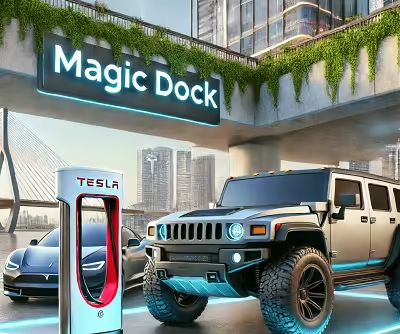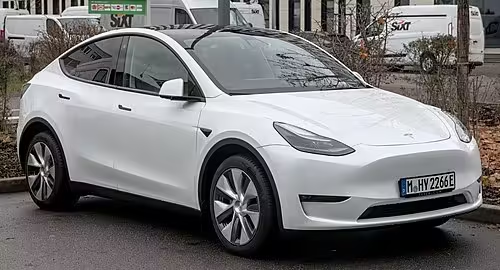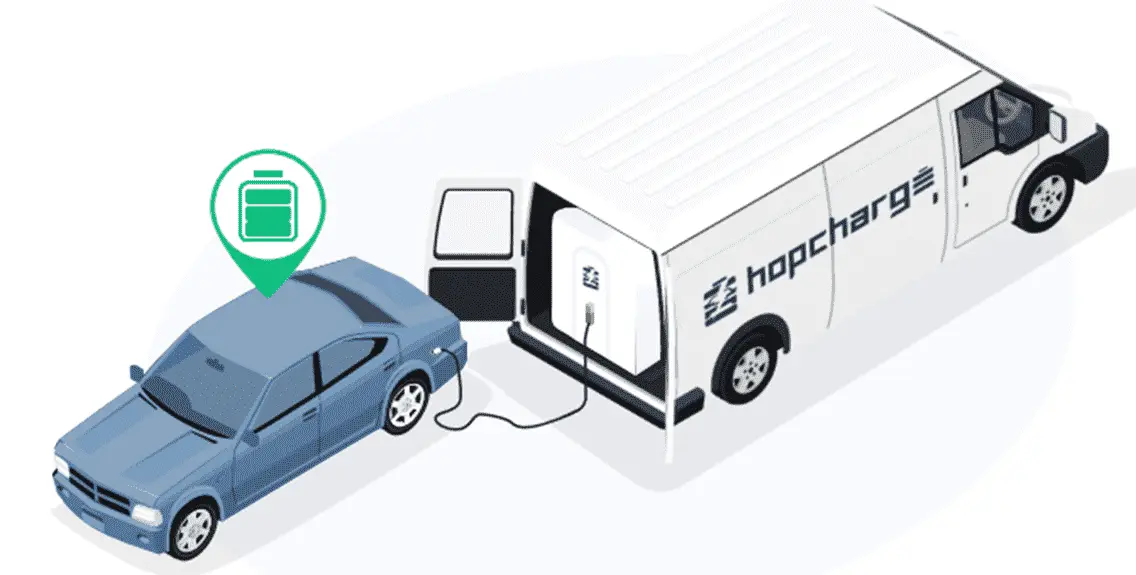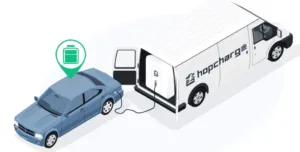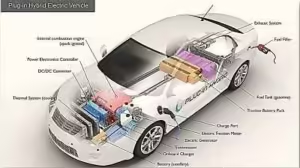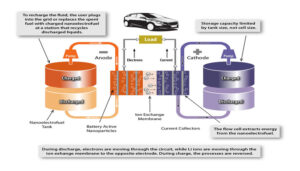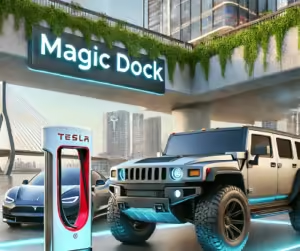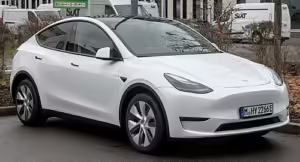Electric vehicles (EVs) are very popular right now, and with good reason! Very quiet and provide greater efficiency. But amid all the discussion about EVs, you may be wondering: what exactly is an electric vehicle ,Types of Electric Vehicles and how do electric cars work? In this blog post, you will learn everything about electric vehicles in a way that you can easily understand.
What is an Electric Vehicle (EV)?
An electric vehicle is a car powered by electricity instead of gasoline. Instead of a rumbling engine, an EV has an electric motor that gets its energy from a large rechargeable battery pack. This battery acts as the car’s fuel tank, storing the electricity that keeps it running.
Types of Electric Vehicles (EVs)
There are four different types of electric vehicles. Battery Electric Vehicles (BEVs) , Hybrid Electric Vehicle (HEV) , Plug-in Hybrid Electric Vehicle (PHEV) and Fuel Cell Electric Vehicle (FCEV). Some of these vehicles still use liquid fuels in combination with electricity. Each with its own characteristics following mentioned.
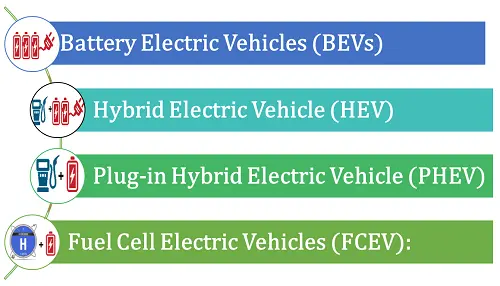
Battery Electric Vehicles (BEVs) :
All electric vehicles, also called to as battery electric vehicles (BEVs), It have a battery pack to store the electrical energy that powers the motor. The batteries are charged by plugging the vehicle in to an electric chargers ( AC001, DC-001 , AC Type-II , CCS Type-2 ).
Both heavy-duty and light-duty all-electric vehicles are commercially available. These are more expensive than hybrids and plug-in hybrids and have typically driving ranges from 150 to 400 miles.

Working Principles : The current for the electric motor is converted into alternating current (AC) by the DC battery. When the accelerator pedal is pressed, a signal is sent to the controller. The controller adjusts the speed of the vehicle by changing the frequency of the alternating current (AC) from the inverter to the motor. The motor then switches on and causes the wheels to turn via a gear wheel.
When the brakes are applied the electric car slows down, the motor becomes an alternator and generates electricity that is fed back into the battery.
Key Components of Battery Electric Vehicles (BEVs):
- Battery : The heart of the BEV, it stores the electricity that fuels the car.
- Charge port: Used to recharge the battery .
- DC/DC converter: Controlling high-voltage DC power as required by electric Car.
- Electric Motor: Motor drives the vehicle’s wheels using power from Battery.
- Onboard charger: Converts it to DC power from AC for charging the Battery
- Power electronics controller: Manages the flow of electrical energy & controlling the speed of Motor.
- Thermal system (cooling):Maintains the proper temperature of operating system, range of the engine, electric motor, power electronics, and other components
- Battery pack : Stores the electricity for electric traction motor.
- Transmission : Transmits the mechanical power to drive the wheels from the electric traction motor.
Hybrid Electric Vehicle (HEV)
Hybrid Electric Vehicles (HEVs) have both engine gas-powered engine and an electric motor to drive the car. The engine’s gets energy from fuel, and the motor gets electricity from batteries.

All the energy for the battery is generated by regenerative braking, which recovers the energy otherwise lost during braking to help the gasoline engine accelerate. In a conventional combustion engine vehicle, this braking energy is normally lost as heat in the brake pads and rotors. Normal hybrids cannot be connected to the electricity grid and cannot be charged with DC Fast Charger.
Key Components of Hybrid Electric Vehicle (HEVs):
Hybrid Electric Vehicle in common components are ” Battery (auxiliary),Traction battery pack , DC/DC converter, Electric traction motor, Power electronics controller Thermal system (cooling), Transmission (electric) ” and other is following below mentioned.
- Fuel filler
- Fuel tank
- Electric generator
- Exhaust system
- Internal combustion engine (spark-ignited)
Plug-in Hybrid Electric Vehicle (PHEV)
PHEV is also known as a series Hybrid Electric Vehicle. PHEVs can drive in two modes; Plug-in Hybrid Electric Vehicles have both an engine and electric motor to drive the car. Like regular hybrids, they can recharge their battery through regenerative braking.
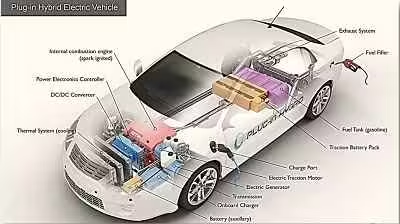
They differ from regular hybrids by having a much larger battery, and being able to plug into the grid to recharge. While regular hybrids can (at low speed) travel 1-2 miles before the gasoline engine turns on, PHEVs can go anywhere from 10-30 miles before their gas engines provide assistance. Once the all-electric range is depleted, PHEVs act as regular hybrids, and can travel several hundred miles on a tank of gasoline.
All PHEVs can charge at an AC charger, but most PHEVs are not capable of supporting DC charger.
PHEVs in common components are Battery (auxiliary), Traction battery pack, DC/DC converter, Electric traction motor, Power electronics controller, Thermal system (cooling), Transmission (electric), Charge port, Onboard charger” and other is following below mentioned.
- Fuel filler
- Fuel tank
- Electric generator
- Exhaust system
- Internal combustion engine (spark-ignited)
- Onboard charger
Fuel Cell Electric Vehicles (FCEV):
Fuel cell electric vehicles are also known as zero-emission vehicles. This Electric vehicle that offer a unique approach to clean transportation. FCEVs use hydrogen gas as ‘fuel cell technology’ to generate the electricity required to run the vehicle.
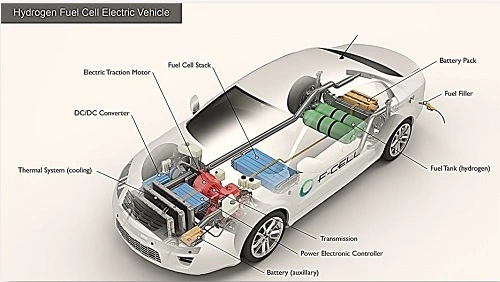
This hydrogen gas undergoes a chemical reaction within the vehicle to generate electricity, powering the car and producing only water vapor as a byproduct.
Key Components of an FCEV:
FCEV in common components are ” Battery (auxiliary),Traction battery pack , DC/DC converter, Electric traction motor, Power electronics controller, Thermal system (cooling), Transmission (electric) ” and other is following below mentioned
- Hydrogen Fuel Tank: Stores compressed hydrogen gas.
- Fuel Cell Stack: The heart of the FCEV, it combines hydrogen and oxygen to create electricity through an electrochemical reaction.
- Power Converter: Regulates the flow of electricity for optimal performance.
,
Definition of Key Components All-Electric Cars :
Now that you understand the basic Definition and working principle, let’s explore the main that make a Electric Cars tick:
Battery Pack: The EV’s Fuel Tank
The battery pack is the heart of the EVs. This powerhouse stores the electricity that fuels the car. Made up of numerous lithium-ion cells, the battery pack holds the key to an EV’s range, meaning how far it can travel on a single charge.
Battery Management System (BMS)
The BMS acts as the brain behind the battery pack. It constantly monitors the battery’s health, including voltage, temperature, and current flow. This information is crucial for ensuring the battery’s safety and maximizing its lifespan.
Electric Motor: The Muscle of the Electric Vehicles
This is the workhorse of the EV, replacing the traditional gasoline engine. The electric motor receives the electricity from the battery pack and converts it into power that drives the wheels. It’s like the engine in a gasoline car, but with a much quieter and cleaner operation. No more noisy engine rumbles here!
Power Converter: Keeping the Flow Going
The power converter acts like a traffic controller for electricity. It regulates the flow of electricity between the battery pack (which stores high-voltage DC power) and the electric motor (which needs lower-voltage DC power). This ensures everything runs smoothly and efficiently.
Cooling System:
All that electrical activity can generate heat, so an EV needs a cooling system just like a traditional car. This system keeps the battery pack, electric motor, and other components at optimal temperatures, ensuring peak performance and preventing overheating.
Onboard Charger
While some EVs can be charged directly from a charging station, others come equipped with an onboard charger. This onboard charger essentially converts the incoming AC electricity (from the outlet or charging station) into DC power for charging the battery pack. It also communicates with the charging equipment, monitoring things like battery temperature and state of charge.
DC/DC Converter :
In some EVs, you might find a DC/DC converter. This nifty component takes the high-voltage DC power from the battery pack and converts it to lower-voltage DC power to run various vehicle accessories like lights, the radio, and the infotainment system.
Charge Port
This is where you connect your EV to an external power source for charging. Think of it as the “gas pump” for electric cars, although the process is much quieter and doesn’t involve any smelly fumes! Depending on the type of charger used, charging times can vary from a few hours to just minutes.
Chargers
Just like your phone, an EV needs to be plugged in to recharge its battery. This can be done at home using a regular wall outlet, although it might take longer to charge. For a faster refill, you can utilize a dedicated electric vehicle charging station. These stations are becoming increasingly common, making it easier to find a charge on the go.
Regenerative Braking – Putting Energy Back In!
This innovative technology helps capture energy that would normally be lost during braking. When you slow down or apply the brakes, the electric motor acts like a generator, converting that braking energy back into electricity and topping off the battery pack for improved efficiency. It’s like putting some energy back into your phone battery when it slows down while scrolling!
So there you have it! These are the key components that work together to power an electric car. With each advancement in technology, these parts are becoming even more efficient and powerful, paving the way for a cleaner and more sustainable future in transportation.
Read also : Energy Management System in Electric Vehicles
Benefits and Challenges in Electric Vehicles
Benefits of Electric Vehicles:
- Lower Running Costs & Low Maintenance Cost: Electric cars are cheaper to operate. Electricity costs less than gasoline, and EVs require less maintenance due to fewer moving parts.
- Zero Tailpipe Emissions & Environmental Friendly: Electric vehicles produce no emissions at the tailpipe, contributing to cleaner air and combating climate change. They also don’t emit harmful toxins like carbon dioxide.
- Tax & Financial Benefits: Many governments offer incentives like road tax exemptions, purchase rebates, and tax breaks to encourage EV adoption, making them more affordable in the long run.
- Long-Term Cost Savings: While the initial cost might be higher, combining lower running costs, reduced maintenance, and potential government incentives can lead to significant savings over time.
- Easy to Drive & Quiet: Electric cars offer a smooth and quiet driving experience due to the electric motor. No loud engine noise means a more peaceful ride for you and a quieter environment.
- Convenience of Charging at Home: Imagine “refueling” your car overnight in your own garage! Many EVs can be conveniently charged at home, eliminating frequent gas station visits.
- Low Fuel Cost Compared to Other Fuels: Electricity is generally cheaper than gasoline or other fuels used in traditional vehicles.
- No Noise Pollution: Electric cars contribute to a quieter environment as they don’t generate the noise pollution associated with gasoline engines.
Challenges of Electric Vehicles:
- Initial High Cost: The upfront cost of purchasing an electric vehicle is still higher compared to conventional gasoline cars, primarily due to the expensive battery technology.
- Limited Public Charging Infrastructure: The network of public charging stations is still developing in many areas, making it inconvenient for long trips or those who lack home charging facilities.
- Limited Range Anxiety: The concern about running out of battery before reaching a charging station (range anxiety) is a major hurdle. While ranges are improving, they might not be sufficient for everyone.
- Long Charging Times: Refueling a gasoline car is much faster than charging an electric vehicle, especially with a standard home outlet. Faster charging options are still evolving.
- Battery Technology & Supply Chain: Lithium-ion batteries, crucial for EVs, rely on specific minerals. Dependence on imports for battery manufacturing can create supply chain vulnerabilities.
- Limited Model Selection: The variety of electric vehicle models available is still lower compared to gasoline cars. More options across different segments and price points are needed to cater to diverse consumer preferences.
FAQs : Some of the most common queries about EVs
What is the range of EVs?
Ans : The average range for EVs varies depending on the model and battery size. Most EVs offer a range between 200-500 kilometers (125-310 miles) on a single charge. However, some long-range models can exceed 600 kilometers (370 miles).
- What is fast charging for EVs? Fast charging, also known as DC fast charging, can significantly reduce charging time compared to a regular outlet. It can take as little as 30 minutes to replenish a battery up to 80% capacity, depending on the charger and vehicle.
- How do EVs affect the electric grid? While a large influx of EVs can put strain on the grid, it can also encourage investment in renewable energy sources. Additionally, features like smart charging can help manage peak demand periods.
- How does the rise of EVs affect natural resources? While EVs eliminate tailpipe emissions, mining for battery materials raises environmental concerns. However, advancements in battery recycling and sustainable sourcing practices are being addressed.
The Future of Electric Cars:
- Is the automotive future electric? It’s certainly trending that way! Governments are setting stricter emission regulations, and advancements in technology are making EVs more affordable and appealing. While gasoline cars may still be around for some time, EVs are likely to become the dominant force in the future.
Profitability:
- Are EVs profitable? How can companies boost the profitability of EVs? Profitability for EV companies can be affected by battery costs and production complexities. Strategies like economies of scale, cost reductions, and offering premium features can boost profitability.
- How are chip shortages affecting the EV market? The global chip shortage has impacted production across industries, including EVs. This can lead to limited vehicle availability and potentially longer wait times.
Competition:
- How can ICE businesses (Internal Combustion Engine) stay competitive? ICE car manufacturers are adapting by developing more fuel-efficient gasoline cars and investing in hybrid and electric vehicle technologies.
Indexes:
- What is the Electric Vehicle Index? There are various electric vehicle indexes that track the performance of companies involved in the EV industry, including battery manufacturers, carmakers, and charging infrastructure providers.
Additional Considerations:
- How long do electric cars last? With proper maintenance, electric car batteries can last around 10-15 years or more. However, factors like charging habits and climate can affect battery life.
- How do I claim the $7500 EV tax credit? (This may vary depending on location). In the US, the federal tax credit of $7500 can be applied when filing your income taxes after purchasing a new qualifying EV. Be sure to consult with a tax advisor for the latest information and specific requirements.
- Which company electric car is best? The “best” EV depends on your individual needs and priorities. Consider factors like range, features, budget, and charging infrastructure availability when making your choice. Researching various models and reading reviews can help you find the perfect EV for you.
- What is the #1 electric car? There isn’t a single “number one” electric car since preferences vary. However, some popular and well-regarded EVs include the Tesla Model 3, Nissan Leaf, Chevrolet Bolt EV, Hyundai Kona Electric, and Kia Niro EV.
This blog post has explain of EVs, understanding the different types to delving into the key components that make them tick. We’ve seen how EVs operate with a focus on clean electricity and regenerative braking to maximize efficiency.
As technology continues to advance, electric vehicles are poised to become even more efficient and accessible. With an expanding charging infrastructure and increasing driving range, EVs are a viable option for a wider range of drivers.
So, are you ready to join the electric revolution? Consider exploring the world of EVs and experience the benefits of a cleaner, quieter, and potentially more cost-effective ride. The future of transportation is electric, and it’s an exciting one!
